![]()
|
Samuel
Lear
(jnr.)
|
Location and period of operation:
|
Samuel Lear (jnr.) |
Hanley |
1877 |
1886 |
Samuel Lear jnr. was a decorator of ware
produced by others and a manufacturer of Jasper, majolica and china
ware at the
Mayer Street
works and in the High Street, Hanley, Stoke-on-Trent, England.
Samuel Lear junior (1852 to 1888), son of the above, (uncle of A. G. Harley Jones).
The Etruscan Majolica blog gives the following information:
|
Mayer Street Works "In about 1877, Samuel Lear erected a small china works on part of the site of the old manufactory, which included as warerooms and offices the residence of Mayers. Mr. Lear produced domestic china and, in addition, decorated all kinds of earthenware made by other manufacturers - a specialty being spirit-kegs. He added to his Mayer Street works a new manufactory, built by himself in 1882, in the High Street and there carried on a successful manufacture of ordinary china, majolica, ivory body earthenware, and Wedgwood-type jasper ware. Samuel Lear fell on bad times in 1886 and his creditors closed the works." Jewitt's Ceramic Art of Great Britain 1800-1900, Revised by Geoffrey Godden
"Samuel Lear. Besides Mr. Lear's china works there is a small earthenware works on the old site carried on by Mrs. Massey; this includes the Mayers' stabling and coach-houses. There are also numerous cottage residences erected in the other spaces." Jewitt's Ceramic Art of Great Britain 1878 |
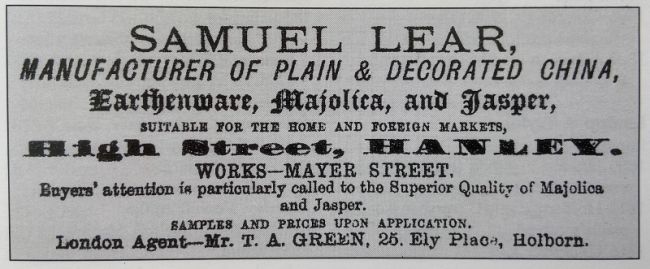
Samuel Lear
Manufacturer of Plain & Decorated China
Earthenware, Majolica, and Jasper,
suitable for the home and foreign markets
High Street, Hanley
Works - Mayer Street
Advert from 1882 Keates Directory
courtesy: R. K. Henrywood, Staffordshire Potters 1781-1900
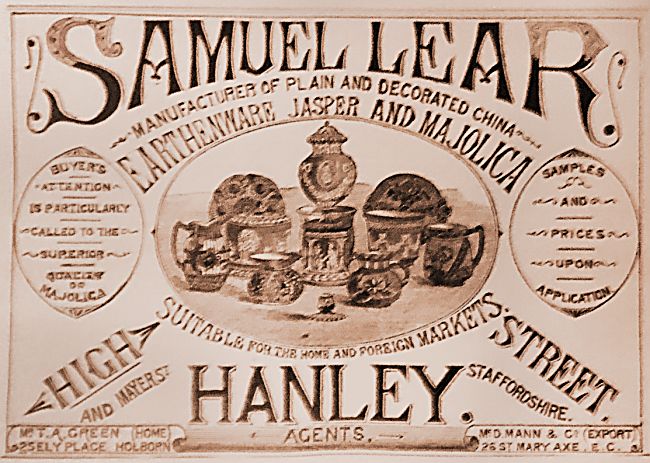
Samuel Lear
Manufacturer of Plain & Decorated China
Earthenware Jasper and Majolica
suitable for the home and foreign markets
High Street and Mayer St. Hanley
Buyers attention is particularly called to the superior quality of
majolica
courtesy: the Etruscan Majolica blog
The London Gazette
25th January 1887
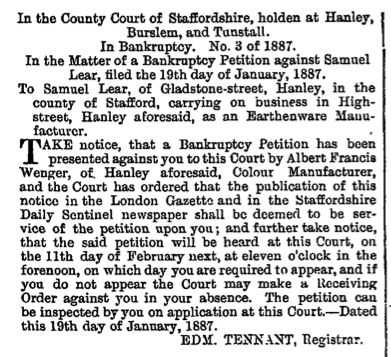
notice of Bankruptcy
Petition presented against
Samuel Lear by Albert Frances Wenger
|
Examples of ware produced: Samuel Lear was a short lived manufacturer, producing ware for around nine years with the main production apparently concentrated in the 1881 to 1886 period. Although Lear produced china and jasper ware it is the prolific manufacturing of majolica that he is known for. For a comprehensive record of Lear majolica ware see the the Etruscan Majolica blog. Lear
employed the services of the pioneering designer Christopher
Dresser who generally designed vases in the aesthetic style for
Lear. |
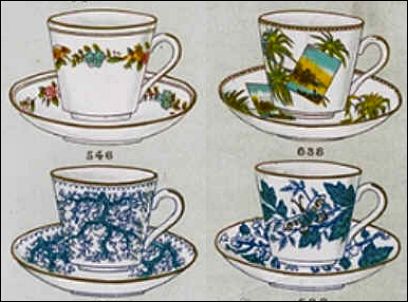
examples of Samuel Lear cups
& saucers
|
These cups & saucers
appear in an advert in a supplement to the April 1883 Pottery Gazette and a
1882 advert lists "Manufacturer of Plain & Decorated China". |
courtesy: the Etruscan Majolica blog
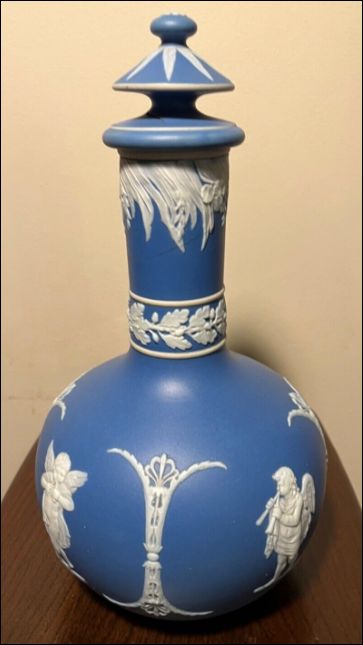 lidded jasper ware vase |
impressed mark |
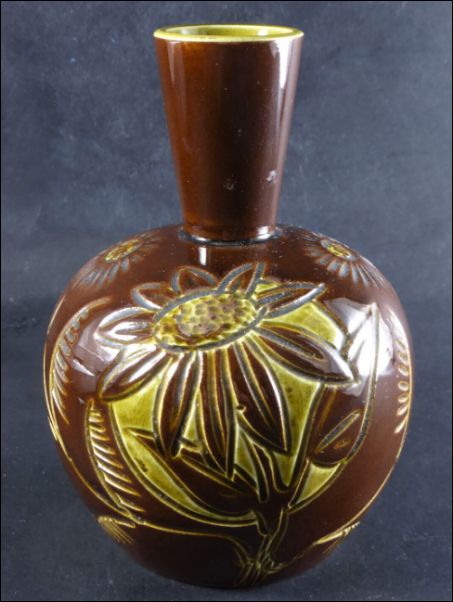 art pottery - earthenware vase in the aesthetic style design attributed to Christopher
Dresser |
 LEAR impressed mark
|
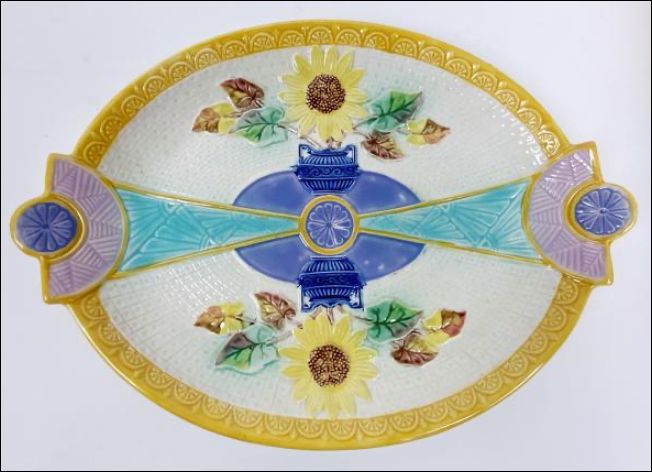 Majolica serving platter in the Sunflower & Urn pattern |
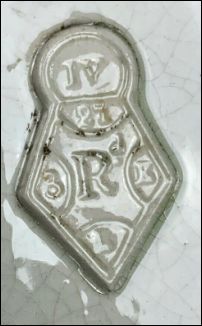
the registration diamond gives the date of
registration of the pattern Registered design number 369202, Samuel Lear, Mayer Street, Hanley |
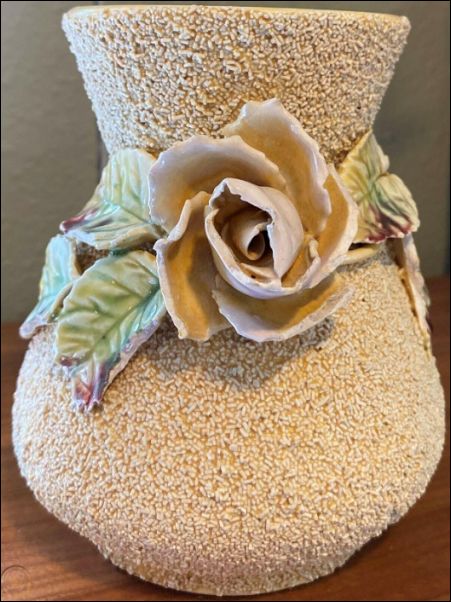 Samuel Lear - Mossed Ware vase Samuel Lear produced a range of patterns in these 'sand' designs, generally incorporating raised flowers. The vase shapes designed by Christopher Dresser were used as a base for some of the mossed ware range.
|
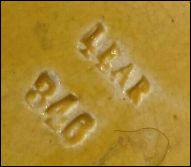
|
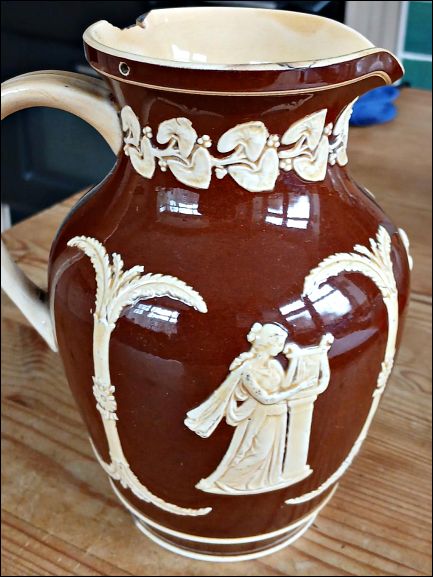 Erato is the Muse of lyric poetry she is often portrayed with a lyre |
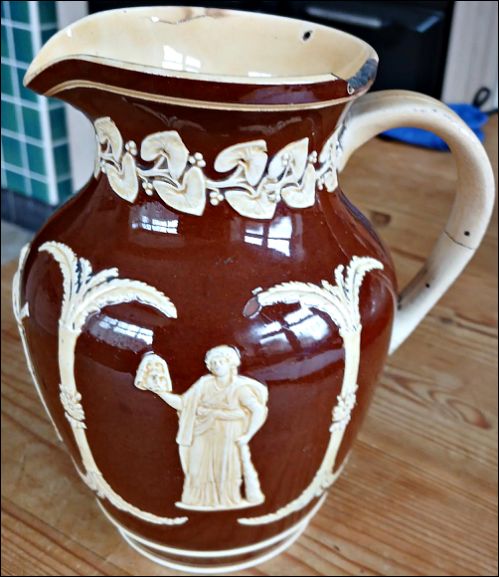 Melpomene is the Muse of tragedy she is often portrayed with a tragic theatrical mask. |
|
|
This brown glaze majolica jug depicts, in white relief decoration, two of the nine Muses of Greek mythology. The Muses were the inspirational goddesses of literature, science, and the arts. In modern figurative usage, a muse is a person who serves as someone's source of artistic inspiration. |
photos courtesy: John Pye
|
Victorian green majolica leaf plates are iconic examples of 19th-century decorative ceramics, popular during the Victorian era (1837–1901). These plates are characterized by their vibrant green glaze, textured surfaces, and intricate leaf designs - molded to resemble a variety of leaves, such as cabbage, grape, or begonia, and often feature raised veins and detailed textures. |
impressed mark
|
photos courtesy: Lin Squire
|
Marks used on ware for identification: All known examples of marking are impressed or cast-in, no printed marks are known. Some pieces produced were not marked but can be identified through advertisements and comparison with other items which are marked. Majolica ware was marked with a registration diamond and no examples are known to have a name pattern. Jasper
and art ware was marked 'Lear' |

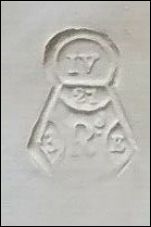
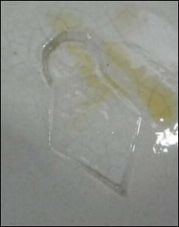
registration diamonds on Lear majolica ware
sometimes
the impressed marks are not clear as they became filled with glaze
during the decorating process, some pieces did not have a mark
Samuel Lear registered eight designs..
|
1878 - 12th July, 6th November 1880 - 17th June 1881 - 13th June, 27th August 1882 - 10th January, 27th May, 14th December |
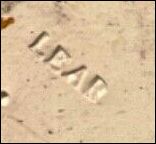
LEAR
impressed mark on jasper ware
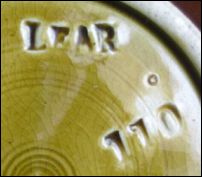
impressed mark |
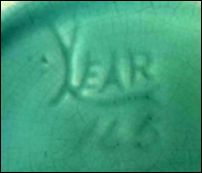
cast-in mark |
marks found on art-ware vases
the numbers probably refer to the design
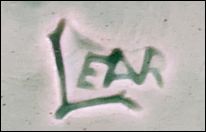
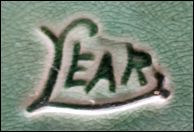
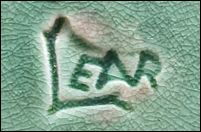
impressed marks on majolica plates
Questions, comments, contributions? email: Steve Birks